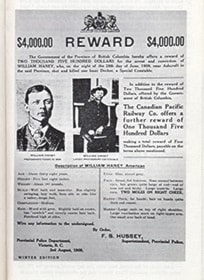The search for the murderer of Isaac Decker was hampered by the fact no one knew who the killer and his dead accomplice were. There had been no identifying marks on the dead man’s person or clothing, nor in the suitcase discovered in the men’s boat. A photograph of the dead bandit, taken by police in Ashcroft, was sent to police departments in Canada and the U.S., but it generated no leads. The engineer and fireman from the train which had been held up on June 21 1909 were shown it, and both men were able to confirm that the dead man was one of those responsible.
The provincial government and the CPR were now, between them, offering a reward of $4,000 for the arrest and conviction of the man who had killed Special Constable Decker, and while this was doubtless an incentive for many people to keep searching, the odds of finding the unidentified man were slim. In the first week of July a Spokane, Washington deputy sheriff identified the dead man as one Lou Kelly, a Canadian ex-policeman gone bad, but this proved to be wrong; while the report, received at the end of July, that a man claiming to be Decker’s murderer had worked at Doc English’s ranch at Venables for a few days seemed more like a tall tale than fact. The only other things approaching clues had been found in the suitcase in the boat. One was a wooden clothes brush, stamped with the imprint of the Long Beach Mercantile Company; the other two were photographs, neither of which showed the unknown men.
It was a long shot, but the clothes brush and one of the photographs – showing a little girl sitting on the porch of a house – were sent to the Chicago Police Department. A Chicago detective named Smith was dispatched to Long Beach, California, where enquiries at the Mercantile Company led nowhere. Smith then took the picture of the dead man, and that of the little girl, to the Long Beach Police Department, to see if anyone there could identify them.
At first it seemed that this would be another dead end. Then Sergeant Phillips of the Long Beach force took another look at the picture of the girl, and something about it jogged his memory. After a search through his papers, Phillips came up with a duplicate of the photo, which had been given to him two years earlier while he was investigating the case of a runaway girl. The girl had been found in Los Angeles, and had told the policemen that she had been taken by a woman to be photographed. Enquiries at picture studios in Los Angeles soon found the correct one, and the photographer was able to provide the name of the woman who had had the picture taken.
The trail was taking some curious twists and turns, but at least there was now a trail to be followed. Sgt. Phillips traced the woman who had had the photograph taken, who remembered it very well. She was also able to remember that she had given a copy of the picture to a man, and she recalled the surname of the man in question. It was Haney, and he lived in Florence, just south of Los Angeles.
It was not long before Sgt. Phillips was meeting with a Mr. and Mrs. Haney in Florence; and the detective knew he had come to the right place. On the Haneys’ mantelpiece was the picture of a man Phillips recognized instantly as the person who had been killed beside the Thompson River in faraway Ashcroft. His name was Dave Haney, and his partner – the man who had killed Special Constable Isaac Decker – was his older brother William, who was thirty-eight, and had previously served three years in prison for a robbery he committed in Calabasas, California.
A B.C. Provincial Police sergeant named Murray was immediately dispatched to Los Angeles, to liaise with the California police and see if Haney had returned to the area following the murder of Isaac Decker. Newspaper reports had Sgt. Murray and the local police chasing Bill Haney as far south as Mexico, but these tales were almost certainly exaggerated, for Murray returned to Canada after a month’s absence with no prisoner and no leads.
It was not until February 1910 that police finally received a tip-off as to Haney’s location. He was, it seemed, back in the Calabasas Hills, about forty miles north of Los Angeles, where he was being given refuge by relatives. Police mounted a raid on the property he was suspected of being in, but Haney had already fled.
Thus began a game of cat-and-mouse, as sheriffs, deputies, private detectives, and bounty hunters chased Bill Haney through the Calabasas Hills. Many of them were probably encouraged by the fact that the reward for the capture of Isaac Decker’s murderer had been increased to $5.500; but Haney continued to elude his pursuers, clearly using his knowledge of the area, and his connections there, to his advantage. At least one of his relatives said that she would happily turn him in so he could get his “just deserts”, but no one managed to find Bill Haney, and gradually the search wound down. Two deputies, on their return to Los Angeles, told the press that they had “almost” caught Haney, and the fugitive wrote to mock them, saying, “I was on the trail next to you. You had better stay in the city, where you have only city folks to deal with.”
At that point, Bill Haney vanished from California. Whether or not he vanished from history at the same time is a matter that is still open to debate, more than one hundred years later.
To be continued
Barbara Roden
